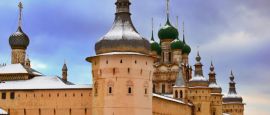Russia Weather, climate and geography
Weather & climate
As you’d expect Russia’s climate is hugely dependent on where in the country you find yourself. With temperatures known to hit a tarmac-melting 37°C (99°F) in the cities and fall to -30°C (-22°F) and lower during the Siberian winter, there’s no point generalising about Russia’s weather except to say, be prepared.
The most favourable temperatures are found along the Baltic coast, where many Muscovites decamp for balmy summer holidays, while the site of the 2014 Winter Olympics, Sochi, also doubles as a beach resort due to its tropical climate, earning it the epithet ‘Florida of Russia’. Minus the overly tanned pensioners of course.
While the notion of visiting a snow-blanketed Moscow or St Petersburg has a definite romance, most tourists prefer to come calling in the warm summer months of June, July and August. This means the shoulder seasons of April, May, September and October are good options for visitors keen to avoid the peak crowds – prices are generally lower from September to May, and tourist sites almost invariably less crowded.
Spring is often characterised by slushy roads. And if your heart’s set on that winter wonderland, December’s the best bet. Seasonal climates apply elsewhere in Russia – Siberia can have devastatingly cold winters, while its summers are generally fairly pleasant, if a little rainy. The region of Russia near the Black Sea has mild winters, but again attracts a fair amount of rain.
Those visiting over summer should pack a mixture of lightweight and mediumweight clothing – natural fibres such as cotton and linen are best. For the winter visitor, meanwhile – layers, layers, layers. Wools and cashmeres are great material for keeping in the warmth. Sturdy shoes are always a good idea, no matter what time of year.
Geography
The Russian Federation covers almost twice the area of the USA, and reaches from the enclave of Kaliningrad in the west over the Urals and the vast Siberian plains to the Sea of Okhotsk in the east. The border between European Russia and Siberia (Asia) is formed by the Ural Mountains, the Ural River and the Manych Depression. All in all, Russia has 16 international borders with countries including Finland, Lithuania, USA, Japan, Ukraine, Azerbaijan and China.
European Russia extends from the North Polar Sea across the Central Russian Uplands to the Black Sea, the Northern Caucasus and the Caspian Sea. Siberia stretches from the West Siberian Plain across the Central Siberian Plateau to the Lena River and takes in the Sayan and Yablonovy ranges in the south. East of Siberia stretches the Russian Far East, a region almost as big as Siberia itself, running to the Pacific coast and including the vast Chukotka and Kamchatka peninsulas.
Given the vast size of the country, Russia’s terrain is hugely variable. From the Siberian tundra to the mountains of the Urals, the beaches on the Black Sea coast, and the plains of western Russia, such variable geography means one can experience many different Russias.
Do you have any Feedback about this page?
© 2025 Columbus Travel Media Ltd. All rights reserved. No part of this site may be reproduced without our written permission, click here for information on Columbus Content Solutions.





 You know where
You know where